It’s always fun to see a hummingbird in the yard. It’s a gem of a bird, and its behaviors are interesting and so unlike other birds.
When they’re in Central NY
Hummingbirds overwinter in Central America. We’re always excited to see them return in the spring and sad to see them leave in the fall.
Check here to see the arrival and departure dates in my yard (for the years I kept track).
Providing habitat for hummingbirds
Hummingbirds, like other birds, need food, water, cover, and a place to raise young.
And, as with other birds, cover includes perching places. We’ve been surprised (though we shouldn’t have been I suppose) by how often hummers perch. Such an active bird definitely needs to rest at times!
They have a few favorite place in our yard. I’ve often noticed them on bare dead branches of trees or shrubs. Another reason not to prune out anything that’s dead!
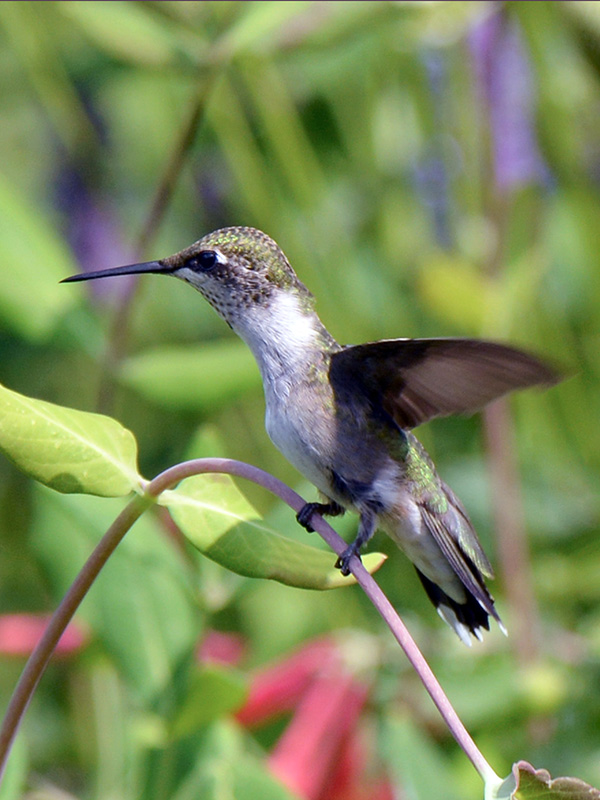
Food

Because of their high metabolism (100 times higher than an elephant’s!) they need to eat frequently. I read that hummingbirds must eat once every 10 to 15 minutes and visit between 1,000 and 2,000 flowers per day.
We focus on meeting this need for readily available food by providing lots of nectar-filled native plants.
We offer nectar in a feeder to supplement these natural sources ONLY in the early spring and the late fall.
And like almost all birds, they need insects for themselves and for their young. This hummingbird is chasing down a tiny gnat.
Our earth-friendly gardening practices are key to producing the insects they need.
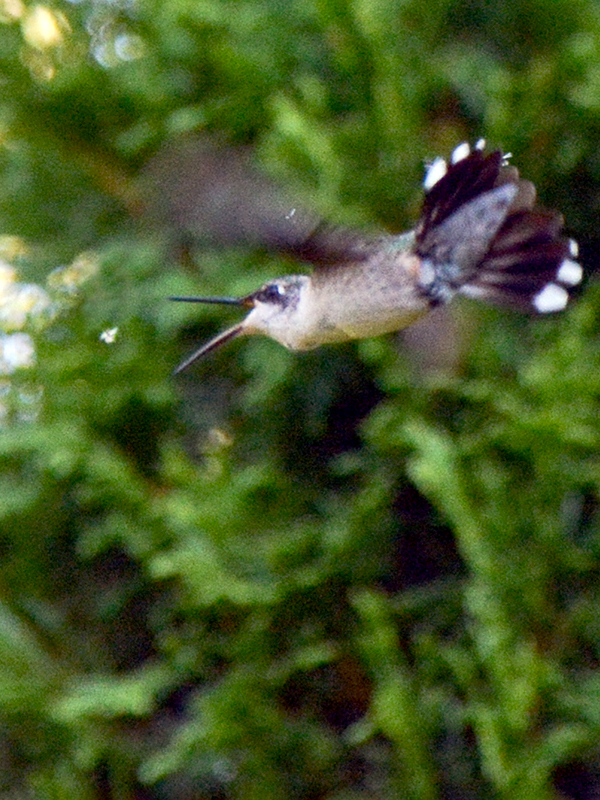
This hummingbird is sticking its tongue out.
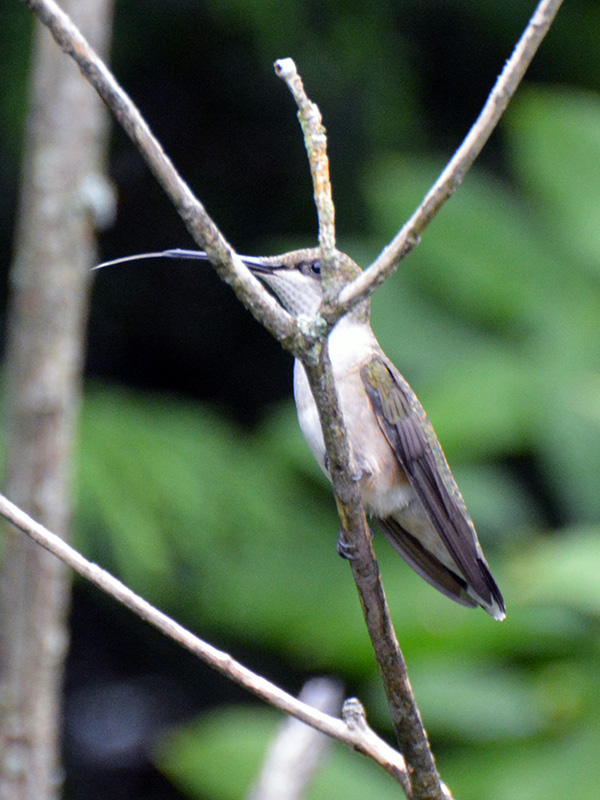
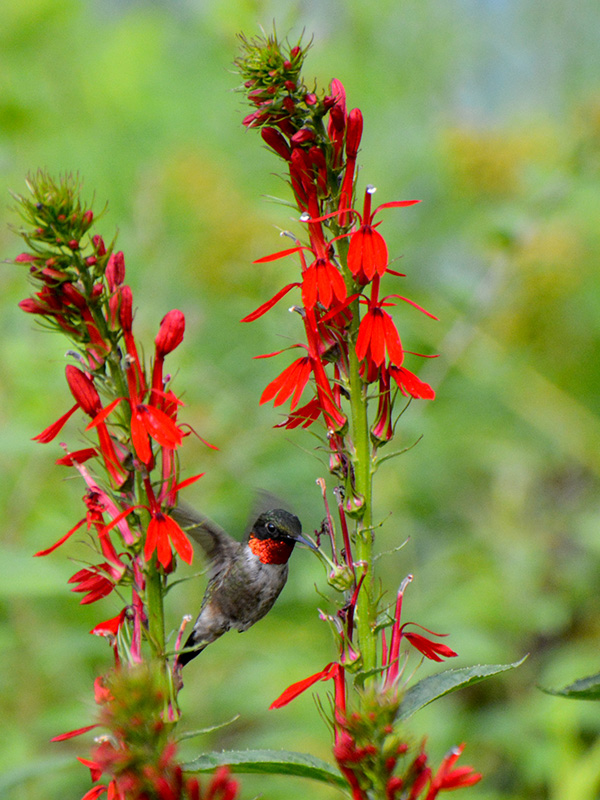
It’s a treat to see this male’s brilliant red gorget which matches its cardinal lobelia flower dinner!
Water
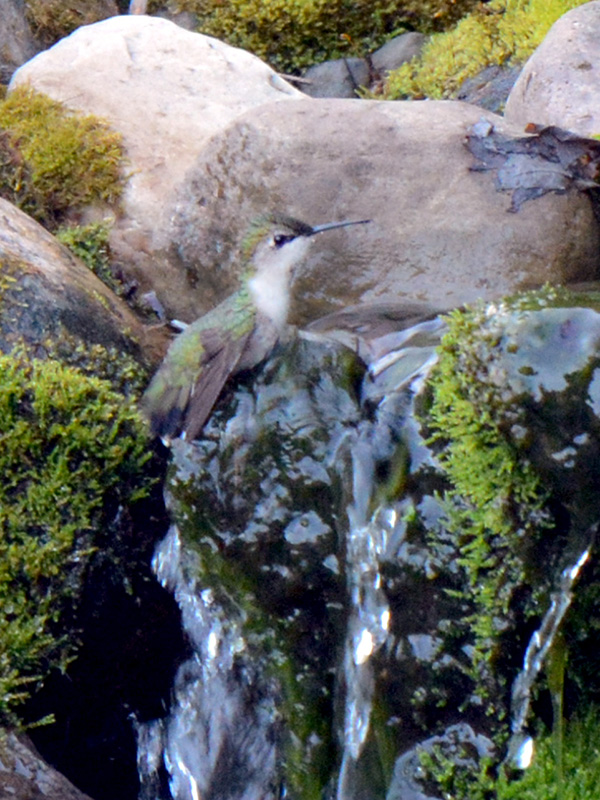
Years ago I wrote: People often say that hummingbirds love to “run through the sprinkler” like kids rather than take a more conventional bird bath, but we don’t have a sprinkler. I assume they can find their own sources of water in our yard; perhaps they even fly near the waterfall to get sprayed. I’ll have to watch more closely.
FINALLY… in 2021 I spotted a hummer actually taking a bath at the top of our waterfall. It was there quite a while, dipping into and out of the water and seeming to enjoy itself.
Cover
Where do hummingbirds go at night or during bad weather? I assume we have lots of places in our yard for this cover. But perching is also part of taking advantage of cover.
Maybe it’s just me, but since hummingbirds are always pictured hovering near a flower, I was initially surprised to see how often hummingbirds just perch.
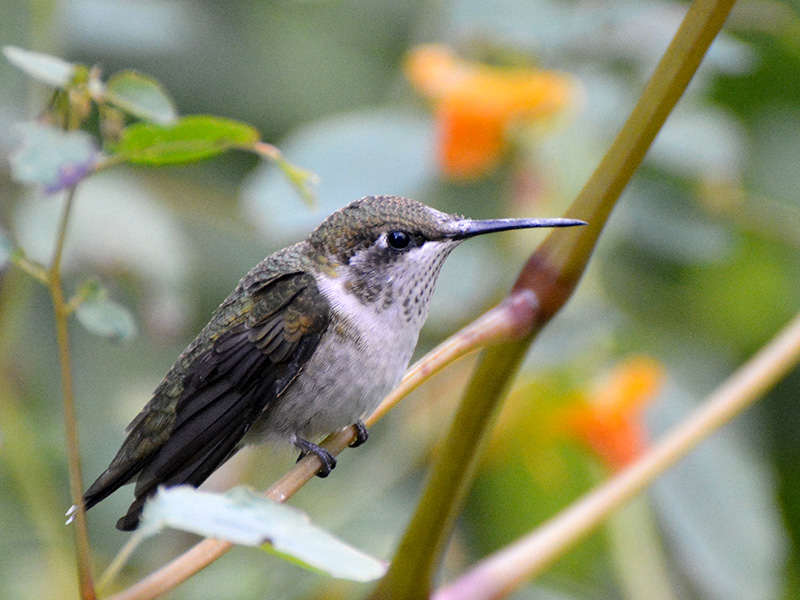
It’s understandable, though. Why would they just hover all the time? It takes a lot of energy, and they’re already a very high-energy-needs creature.
We leave a variety of dead branches or even entire dead trees, which provide much-used habitat resources even after they’ve died.
And some of that perching time is used to take care of its feathers. It must be hard to do with such a long beak!
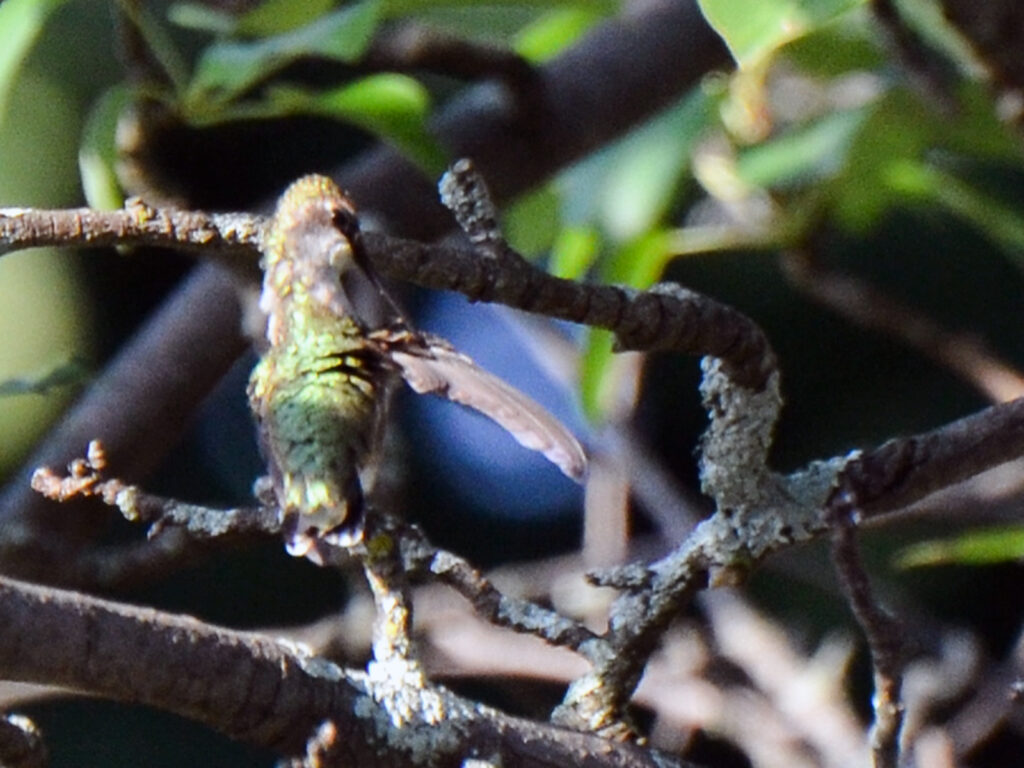
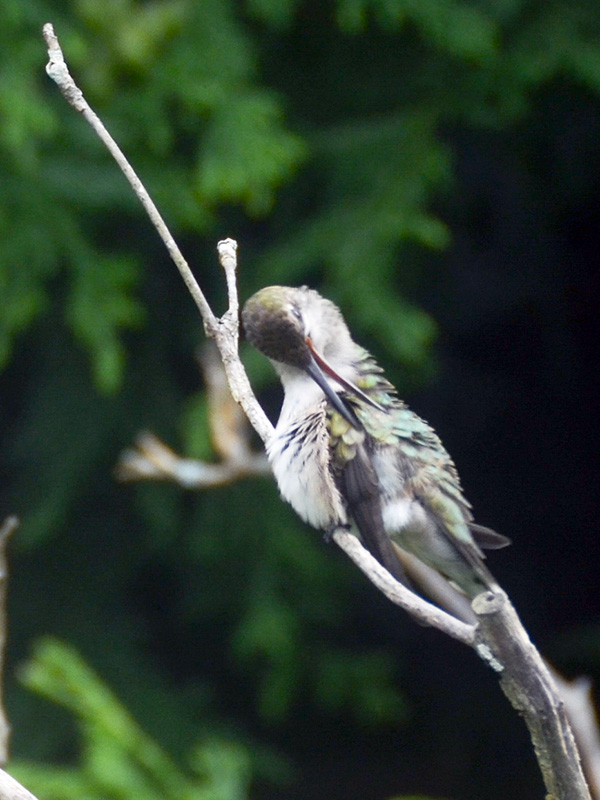
A place to raise young
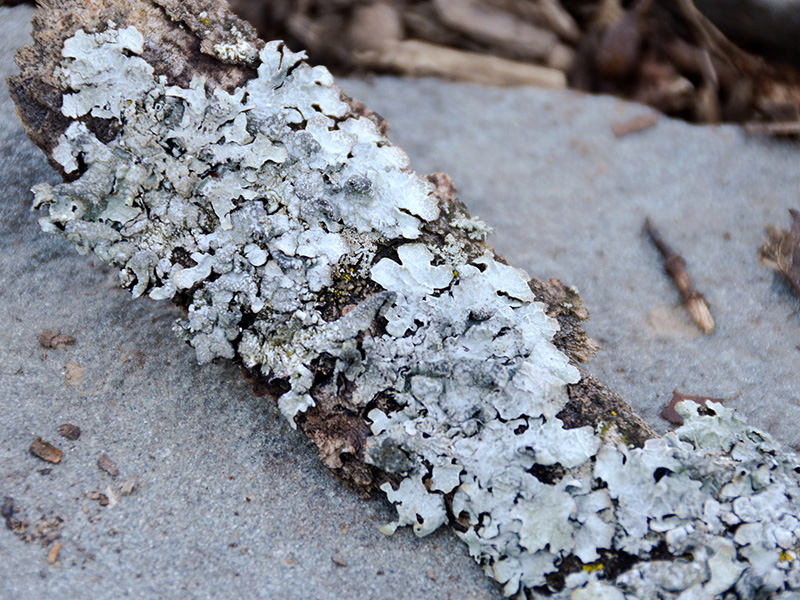
We haven’t ever seen a hummingbird nest. I think it would be very unlikely since they’re so tiny and they’re so well-camouflaged with lichen (such as in the photo) and other natural materials.

We probably have more spiders in our pesticide-free yard than in other people’s yards.
That means we’re providing one of the important nest-building materials for hummingbirds: strong, flexible spider webs that allow the nest to expand as the tiny birds grow.
Feisty!
Hummers are feisty little creatures fighting fellow hummers as well as other creatures! I’ve seen them chasing away much larger birds as well as bees.
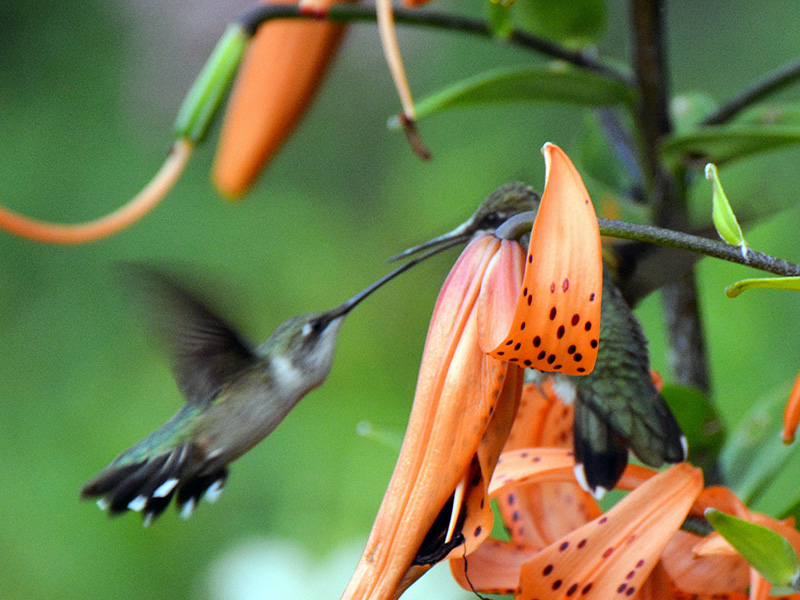
These two continued a beak-to-beak battle out of the back yard, over the fence and through the side yard.
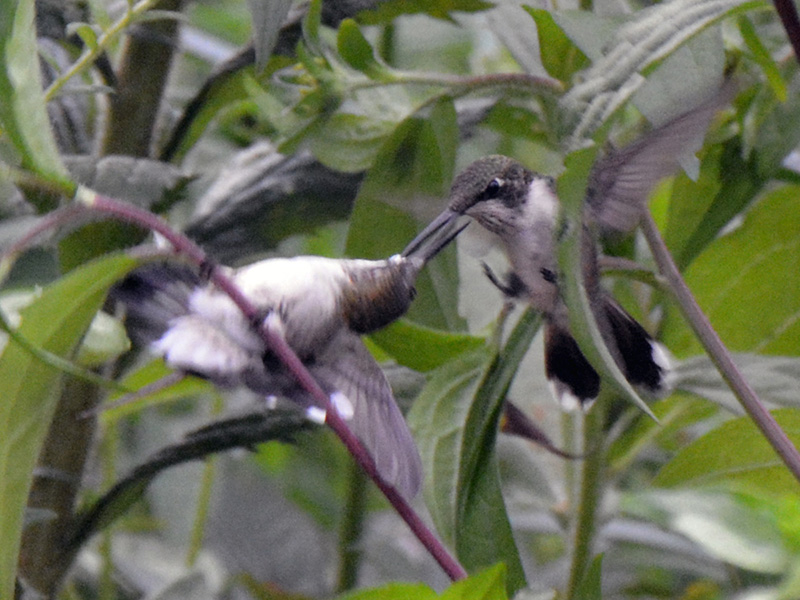
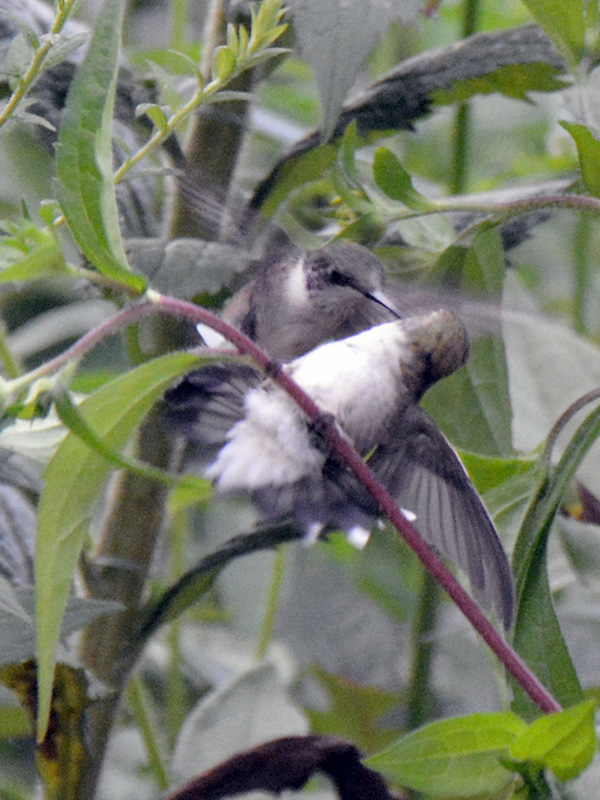

Could he have been trying to catch this bumblebee to eat? He almost got it once as he chased it around the raspberry patch. Can he even eat such a big insect? I don’t know. Maybe a case of “his eyes being bigger than his stomach” or maybe he was just defending his territory from another small creature.
I’ve also seen chasing away much larger birds. Fearless!
Conservation
Hummingbirds can die rather quickly if they get caught in a garage or somewhere where there isn’t a supply of food.
Unfortunately getting caught in a garage can easily happen since apparently there’s a law that automatic garage door openers must have red handles of some sort — unfortunately the color that attracts hummingbirds.
I’ve read that the longest-living hummingbird found so far is over nine years old, and that this banded bird had been recaptured more than six times — in the same yard! The same person who recaptured the banded bird estimated that in its lifetime it had traveled at least 36,000 miles during migration and possibly as much as 49,000 miles depending on where it spent the winter!
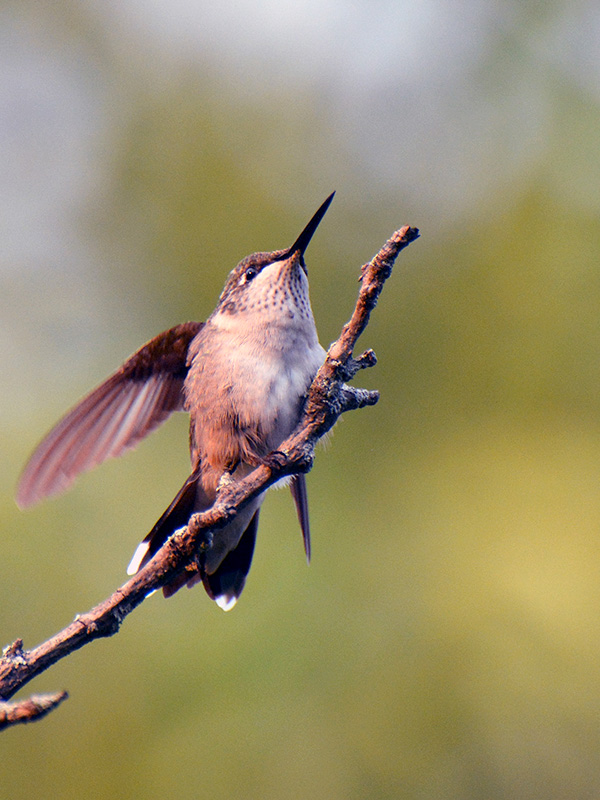
Although most birds don’t live as long as that, it’s interesting to know that the hummer we see in our yard may indeed be the same exact bird we’ve enjoyed in years past.
If so, we’re pleased that it found good enough habitat in our yard to want to return.
But that means that another issue we’re concerned about is maintaining its winter habitat. This is crucial for its survival and so they can continue making the journey back to our yards. But it winters in Central America, so what can we do? Buy Bird Friendly Habitat certified coffee that conserves critical winter habitat!
Resources
- Cornell Lab of Ornithology:
- Journey North: Excellent resources on our ruby-throated hummingbird:
- Hummingbirds overview (especially good for teachers).
- Resources to Explore section – Spectacular photos of nests etc
- Hummingbird nest and babies – amazing photos of them as they grow up
- Summer and winter range maps – relatively little land is available in the winter, so conservation of winter habitat important
- American Bird Conservancy:
- PBS Nature:
- VIDEO: Nature Season 35 Episode 1 NOTE: No longer streaming for free, but available with a PBS Passport or possibly at some libraries. [A PBS Passport is available through local stations and not only allows you to access lots of fascinating shows, but also supports public broadcasting.]
- Hummingbirds.net:
- Hummingbirds.net has a wealth of information about hummingbirds. They also have answers to some common questions such as what to do if you have a hummer trapped in the garage (which can happen since they’re attracted by the red garage door handles).
- Maine Cooperative Extension:
- Audubon:
- Hilton Pond Center:
- Birds of a feather: Hummingbird molt – AMAZING photos of a hummingbird molting!
- Two venerable hummingbirds – returning to the exact location for at least six years!
- YouTube miscellaneous:
- Bird Watcher’s General Store:
Reflections
- Choose Natives:
Factoids
- Hummingbirds weigh 1/10 ounce — the weight of a penny
- Hummingbirds’ brains are about the size of a BB
- Their legs are underdeveloped so they are unable to walk
- The mother weighs only about 8 times more than her egg
- They generally lay 2 eggs about the size of a blueberry
- They use spider webs as glue to attach the nest to a tree branch as well as a binding agent for the building materials
- Hummingbirds eat about every 10 minutes
~ From Wild Birds Unlimited Bird Tracks Online
